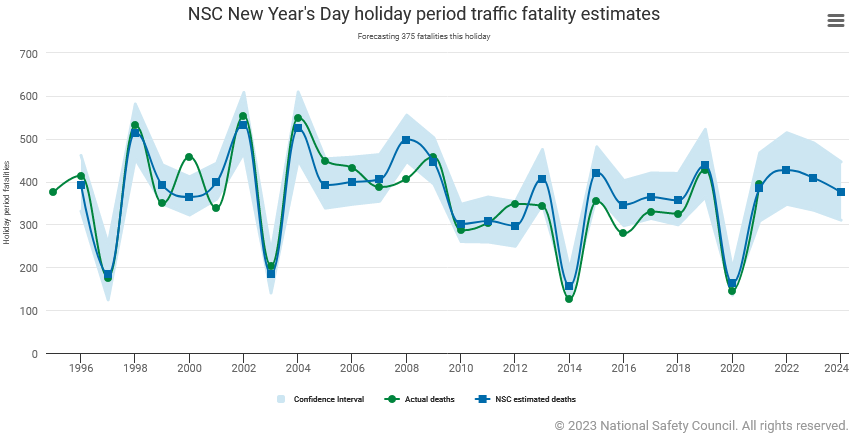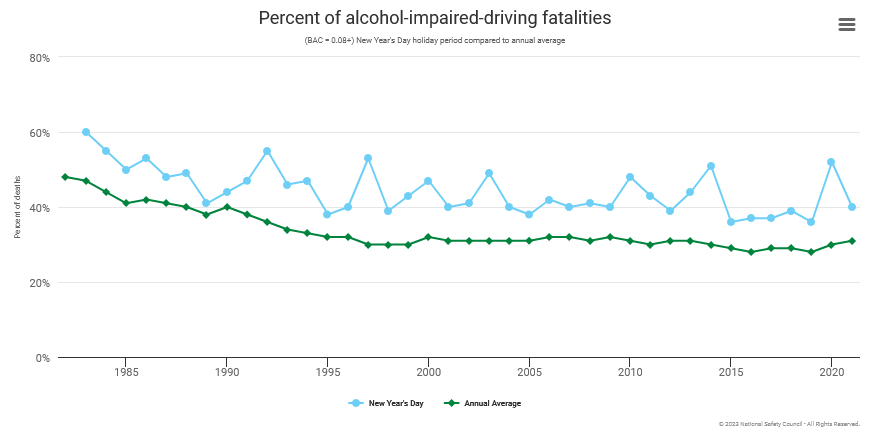An estimated 375 people could die on U.S. roads this New Year’s Day holiday period, according to analysis by the National Safety Council (NSC).
This number is down 8 percent from the 408 deaths estimated for the 2023 New Year’s Day holiday period.
New Year’s Day is observed on January 1. The New Year’s Day holiday period varies from 1.25 to 4.25 days in length, depending on which day of the week the holiday falls. In 2024, New Year’s Day falls on a Monday, so the holiday period is 3.25 days and extends from 6 p.m. Friday, Dec. 29, 2023 to 11:59 p.m. Monday, Jan. 1, 2024.
Travel during the holiday season is a given, with car travel having the highest fatality rate of any major form of motorized transportation based on fatalities per passenger mile.
Holidays are also often a cause for celebrations involving alcohol consumption, a major contributing factor to motor vehicle crashes, the NSC noted.
The 90 percent confidence interval for the estimate of traffic deaths this holiday is 310 to 446.
The chart below shows NSC New Year’s Day holiday fatality estimates and confidence intervals compared to the actual number of deaths. The latest final fatality data available are for 2021. NSC underestimated the actual number of New Year’s Day deaths in 2021 by 2.8 percent, falling within the confidence interval.

Source: Estimates and confidence intervals are calculated by NSC; actual deaths reflect NSC analysis of National Highway Traffic Safety Administration (NHTSA) Fatality Analysis Reporting System (FARS) data.
Injuries
A medically consulted injury is an injury serious enough that a medical professional was consulted, according to the NSC.
Based on the current medically consulted injury to death ratio of 114:1 and rounded to the nearest hundred, the estimate of nonfatal medically consulted injuries that will result from crashes during the holiday period is 42,800, with a 90 percent confidence interval of 35,400 to 50,800, the anlaysis found.
Seat Belt Impact
Studies show seat belts, when used, are 45 percent effective in preventing fatalities among front-seat passenger car occupants (see note below for more details). An estimated 149 lives may be saved this New Year’s Day holiday period because vehicle occupants wear their seat belts. An additional 87 lives could be saved if everyone wears seat belts.
Impaired Driving
Nationwide, alcohol-impaired fatalities (involving blood-alcohol content of 0.08 g/dL or higher) in 2021 represented 31 percent of the total traffic fatalities, the analysis found.
During the 2021 (latest available data) New Year’s Day holiday period, 40 percent of fatalities involved an alcohol-impaired driver. This chart shows the historic trend of the percent of fatalities involving an alcohol-impaired driver.






















 Artificial Intelligence Is Rewriting the Rules for Commercial Lines
Artificial Intelligence Is Rewriting the Rules for Commercial Lines  The Hardest Part of Innovation in Insurance Isn’t Technology; It’s Culture
The Hardest Part of Innovation in Insurance Isn’t Technology; It’s Culture  Unpacking a Consumer Intervenor’s Novel Idea
Unpacking a Consumer Intervenor’s Novel Idea  Executives on the Move at HSB, American Modern Insurance Group, AIG
Executives on the Move at HSB, American Modern Insurance Group, AIG 



